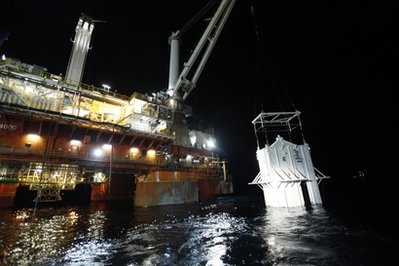
The containment vessel is lowered into the Gulf of Mexico at the site of the Deepwater Horizon rig collapse, Thursday, May 6, 2010. [Agencies]
|
|
ON THE GULF OF MEXICO - Workers eased a giant concrete-and-steel box into the Gulf of Mexico, starting the long process of lowering the contraption over the blown-out oil well at the bottom of the sea in an untested bid to capture most of the gushing crude and avert a wider environmental disaster.
The whole structure could be operating by Sunday.
"We haven't done this before," said BP spokesman David Nicholas. "It's very complex and we can't guarantee it."
The mission took on added urgency as oil started washing up on delicate barrier islands.
Dangerous fumes rising from the oily water on a windless night had delayed the lowering of the box for hours. The fear was that a spark caused by the scrape of metal on metal could cause a fire.
But a crane lifted it from the deck of the supply boat Joe Griffin and into the Gulf after 10 p.m. local time, dark oil clinging to its white sides as it entered the water and disappeared below the surface.
The technology has been used a few times in shallow waters, but never at such extreme depths -- 5,000 feet (1,500 meters) down, where the water pressure is enough to crush a submarine.
The box -- which looks a lot like a peaked, 40-foot (12-meter) high outhouse, especially on the inside, with its rough timber framing -- must be accurately positioned over the well, or it could damage the leaking pipe and make the problem worse.
BP spokesman Doug Suttles said he is not concerned about that happening. Underwater robots have been clearing pieces of pipe and other debris near where the box will be placed to avoid complications.
"We do not believe it could make things worse," he said.
Other risks include ice clogs in the pipes -- a problem that crews will try to prevent by continuously pumping in warm water and methanol -- and the danger of explosion when separating the mix of oil, gas and water that is brought to the surface.
"I'm worried about every part, as you can imagine," said David Clarkson, BP vice president of engineering projects.
If the box works, a second one now being built may be used to deal with a second, smaller leak from the sea floor.
"Hopefully, it will work better than they expect," the supply boat's first mate, Douglas Peake, told an Associated Press reporter on board.